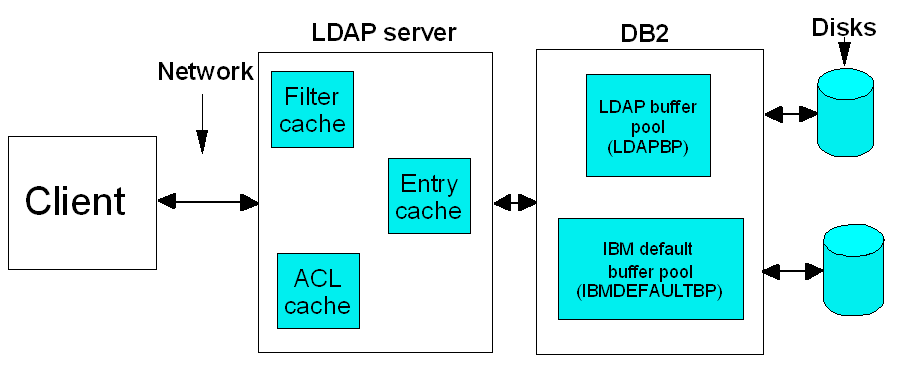
Second Edition (December, 2002)
This edition applies to version 5, release 1, of The IBM Directory and to all subsequent releases and modifications until otherwise indicated in new editions.
(C) Copyright International Business Machines Corporation 2002. All rights reserved.
U.S. Government Users Restricted Rights -- Use, duplication or disclosure restricted by GSA ADP Schedule Contract with IBM Corp.
IBM Directory tuning general overview
Appendix B. Platform configurations
Welcome to the IBM Directory Server Performance Tuning Guide. The purpose of this document is to provide performance tuning information for IBM Directory Server. The document is divided into sections dealing with LDAP server, IBM Universal Database 2 (DB2(R)), AIX(R) operating system, and hardware tuning issues.
For the most current and accurate tuning information, see the Web version of the Performance Tuning Guide on the IBM Directory Web site:
http://www-4.ibm.com/software/network/directory/library
The target audience for this guide includes:
This guide uses several typeface conventions for special terms and
actions. These conventions have the following meaning:
| Bold | Command names and options, keywords, and other information that you must type as shown. |
| Italics | Variables and values you must provide appear in italics. |
| Monospace | Code examples, command lines, screen output, file names, programming keywords, message text or prompts addressed to the user, and text that the user must enter appear in monospace font. |
This guide provides tuning information for the IBM Directory Server and related IBM Database 2 (DB2) database. The IBM Directory Server is a Lightweight Directory Access Protocol (LDAP) directory that provides a layer on top of DB2, allowing users to efficiently organize, manipulate and retrieve data stored in the DB2 database. Tuning for optimal performance is primarily a matter of adjusting the relationships between the LDAP server and DB2 according to the nature of your workload.
Because each workload is different, instead of providing exact values for tuning settings, we have provided, where appropriate, guidelines for how to determine the best settings for your system. The measurements in this guide use the DirectoryMark (DirMark) 1.2 industry-standard benchmark provided by Mindcraft Inc., but the processes outlined can be applied to any workload. See Appendix A, DirMark 1.2 and Appendix B, Platform configurations for more information about DirMark 1.2 and the platform configurations used in the guide's examples.
For the most current and accurate tuning information, see the Web version of the Performance Tuning Guide on the IBM Directory Server Web site:
http://www-4.ibm.com/software/network/directory/library
The following figure illustrates how IBM Directory Server components interact with each other. Tuning these components can result in improved performance.
Figure 1. IBM Directory Server 5.1

The arrows in Figure 1 represent the path of a query issued from a client machine. The query follows a path from the IBM Directory Server client to the LDAP server, to DB2, to the physical disks in search of entries that match the query's search filter settings. The shorter the path to matching entries, the better overall performance you can expect from your system.
For example, if a query locates all the matching entries in the LDAP Server, access to DB2 and the disks is not necessary. If the matching entries are not found in the LDAP Server, the query continues on to DB2, and, if necessary to the physical disks as a last resort. Because of the time and resources it takes to retrieve data from disk, it is better from a performance standpoint to allocate a significant amount of memory to the LDAP server caches and DB2 buffer pools.
Caches and buffer pools store previously retrieved data and can significantly improve performance by reducing disk access. When requested data is found within a cache or buffer pool, it is called a cache hit. A cache miss occurs when requested data is not located in a cache or buffer pool.
Because the type of information in each cache and buffer pool differs, it is useful to understand why and when each cache is accessed.
There are three LDAP caches:
See LDAP filter cache for more information.
See Entry cache for more information.
There are two DB2 buffer pools:
See LDAPBP buffer pool size for more information.
The LDAP caches are generally more efficient as a means of caching LDAP searches; however, parts of the LDAP cache get invalidated on updates and must be reloaded before performance benefits return. Some experimentation between the two caching schemes is required to find the best memory allocation for your workload. See Filter cache bypass limits for more information.
Tuning the LDAP server can significantly improve performance by storing useful data in the caches. It is important to remember, however, that tuning the LDAP server alone is insufficient. Some tuning of DB2 is also required for optimal performance.
The most significant performance tunings related to the IBM Directory Server involve the LDAP caches. LDAP caches are fast storage buffers in memory used to store LDAP information such as queries, answers, and user authentication for future use. While LDAP caches are mostly useful for applications that frequently retrieve repeated cached information, they can greatly improve performance by avoiding calls to the database. See LDAP caches for information about how to tune the LDAP caches.
DB2 serves as the data storage component of the IBM Directory Server. Tuning DB2 results in overall improved performance.
This guide contains several recommendations for tuning DB2, but the most commonly tuned items are:
Attention: You must place the DB2 log on a physical disk drive separate from the data. While there might be some performance benefit to having the DB2 log and data on different drives, data-integrity concerns require the separation. Use the following command to set the path to the DB2 log file directory:
UPDATE DATABASE CONFIGURATION FOR database_alias USING NEWLOGPATH pathBe sure the database instance owner has write access to the specified path or the command fails.
The following are some generic tips that can help improve performance:
This chapter discusses the following performance tuning tasks for the IBM Directory Server:
LDAP caches are fast storage buffers in memory used to store LDAP information such as queries, answers, and user authentication for future use. Tuning the LDAP caches is crucial to improving performance.
An LDAP search that accesses the LDAP cache can be faster than one that requires a connection to DB2, even if the information is cached in DB2. For this reason, tuning LDAP caches can improve performance by avoiding calls to the database. The LDAP caches are especially useful for applications which frequently retrieve repeated cached information. See Figure 1 for an illustration of the LDAP caches.
The following sections discuss each of the LDAP caches and demonstrate how to determine and set the best cache settings for your system. The examples used in the tables and measurements are based on DirMark 1.2 data. Keep in mind that every workload is different, and some experimentation will likely be required in order to find the best settings for your workload.
When the client issues a query for some data, the first place the query goes is the filter cache. This cache contains cached entry IDs. There are two things that can happen when a query arrives at the filter cache:
To determine how big your filter cache should be, run your workload with the filter cache set to different values and measure the differences in operations per second. For example, Figure 2 shows the varying operations per second based on different filter cache sizes:
Figure 2. Varying the size of the filter cache
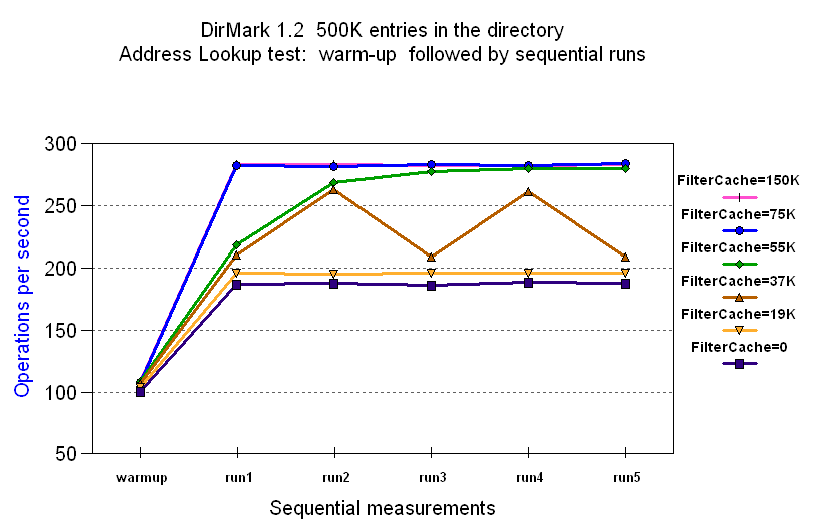
From the results in Figure 2, it can be concluded that for this workload, there is little benefit to a filter cache size of 20,000 over no filter cache at all. Sizes in the 20,000-50,000 range result in unpredictable varying behaviors as some queries hit in the cache while others miss.
For this workload it appears that a filter cache large enough to hold
75,000 entries results in the best performance. There is no benefit in
making the filter cache any larger than this. The following table shows
that setting the filter cache at 75,000 results in 50% more operations per
second than if the filter cache was set to zero:
Table 1. Effects of varying the size of the filter cache
| Filter cache size | 75,000 | 0 |
|---|---|---|
| Filter cache bypass limit | 100 | 100 |
| Entry cache size | 460,000 | 460,000 |
| Address Lookup (operations per second) | 283 | 188 |
| Address Lookup warmup (operations per second) | 108 | 101 |
See LDAP cache configuration variables to set the filter cache size.
Figure 3 shows that there is no performance benefit in allocating any memory to the filter cache if even a small fraction of the operations in the workload are updates.
If this proves to be the case for your workload, the only way to retain the performance advantage of a filter cache when updates are involved is to batch your updates. This allows long intervals during which there are only searches. If you cannot batch updates, specify the filter cache size of zero and allot more memory to other caches and buffer pools. See LDAP cache configuration variables for instructions on how to set configuration variables such as filter cache size.
Figure 3. Effect of updates on the performance of the filter cache
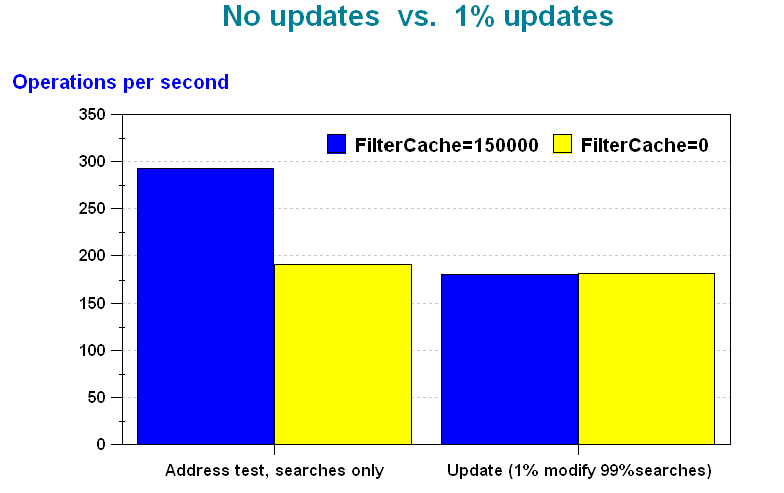
The filter cache bypass limit configuration variable limits the number of entries that can be added to the filter cache. For example, if the bypass limit variable is set to 1,000, search filters that match more than 1,000 entries are not added to the filter cache. This prevents large, uncommon searches from overwriting useful cache entries. To determine the best filter cache bypass limit for your workload, run your workload repeatedly and measure the throughput.
For example, Figure 4 shows the operations per second based on varying cache bypass limit sizes.
Figure 4. Varying the filter cache bypass limit
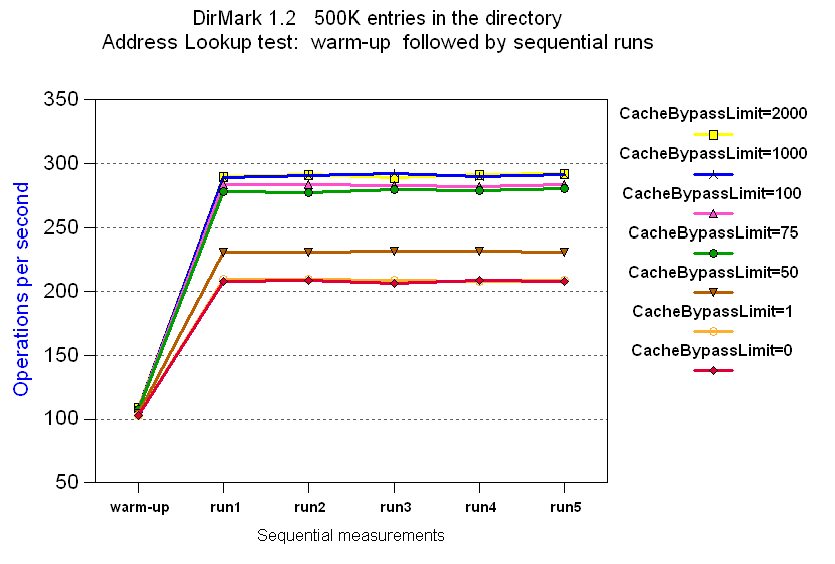
For the workload in Figure 4, setting the limit too low hurts performance by preventing valuable filters from being cached. Setting the filter bypass limit to approximately 100 appears to be the best size for this workload. Setting it any larger benefits performance only slightly.
See LDAP cache configuration variables to set the filter cache bypass limit.
The entry cache contains cached entry data. Entry IDs are sent to the entry cache. If the entries that match the entry IDs are in the entry cache, then the results are returned to the client. If the entry cache does not contain the entries that correspond to the entry IDs, the query goes to DB2 in search of the matching entries.
To determine how big your entry cache should be, run your workload with the entry cache set to different sizes and measure the differences in operations per second. For example, Figure 5 shows the varying operation per second based on different entry cache sizes:
Figure 5. Varying the size of the entry cache
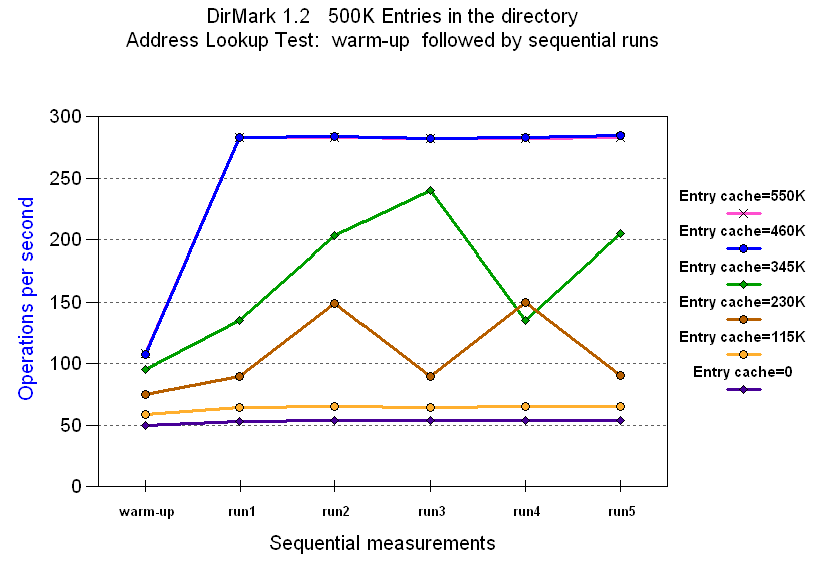
From the results in Figure 5, it can be concluded that for this workload, there is little benefit to an entry cache size of 100,000 over no entry cache at all. Sizes in the 200,000-400,000 range result in unpredictable varying behaviors as some queries hit in the cache while others miss.
For this workload it appears that an entry cache large enough to hold
460,000 entries results in the best performance. There is no benefit to
making the entry cache any larger than this. Setting the entry cache at
460,000 results in 5 times as many operations per second than if entry cache
was set to zero:
Table 2. Effects of varying the size of the entry cache
| Entry cache size | 460,000 | 0 |
|---|---|---|
| Filter cache size | 100 | 100 |
| Filter cache bypass limit | 150,000 | 150,000 |
| Address Lookup (operations per second) | 284 | 54 |
| Address Lookup warmup (operations per second) | 107 | 50 |
To find the best cache size for your workload, you must run your workload with different cache sizes. See LDAP cache configuration variables to set the filter cache size.
When the entry cache bypass limit is set to any value, the filter cache bypass limit applies to the entry cache as well.
Cache sizes are measured by number of entries. When determining how much memory to allocate to your LDAP caches, it can be useful to know how big the entries in your cache are in megabytes.
The following example shows how to measure cached entries in megabytes:
(ibmslapd size2 - ibmslapd size1) / (entry cache population2 - entry cache population1)
For example, using this formula with the 500,000-entry database used by DirMark 1.2 results in the following measurement:
(192084KB - 51736KB) / (48485 - 10003) = 3.65KB per entry
LDAP cache configuration variables allow you to set the LDAP cache sizes, bypass limits, and other variables that affect performance.
You can set LDAP configuration variables using the Web Administration Tool or the command line.
To set LDAP configuration variables using the Web Administration Tool:
To set LDAP configuration variables using the command line, issue the following command:
ldapmodify -DAdminDN -wAdminpassword -ifilename
where the file filename contains:
dn: cn=Directory,cn=RDBM Backends,cn=IBM Directory,cn=Schemas,cn=Configuration
changetype: modify
replace: ibm-slapdDbConnections
ibm-slapdDbConnections: 15
dn: cn=Front End, cn=Configuration
changetype: modify
replace: ibm-slapdACLCache
ibm-slapdACLCache: TRUE
-
replace: ibm-slapdACLCacheSize
ibm-slapdACLCacheSize: 25000
-
replace: ibm-slapdEntryCacheSize
ibm-slapdEntryCacheSize: 25000
-
replace: ibm-slapdFilterCacheSize
ibm-slapdFilterCacheSize: 25000
-
replace: ibm-slapdFilterCacheBypassLimit
ibm-slapdFilterCacheBypassLimit: 100
There are several additional settings that affect performance by putting limits on client activity, minimizing the impact to server throughput and resource usage, such as:
It is possible to measure how the size of your directory impacts performance by running your workload with different directory sizes. For example, if your current directory contains 500,000 entries, try tuning your workload with a 100,000 entry directory and a 1,000,000 entry directory.
It is important when you run your workload that you consider several measurements. For example, measuring the number of operations per second as shown in Figure 6, it appears that performance degrades significantly as the the database size grows.
Figure 6. Operations per second
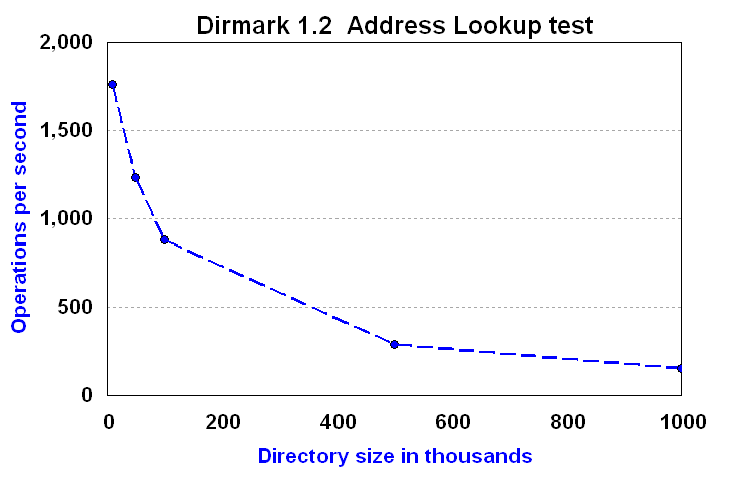
However, the DirMark Address Lookup test includes a large fraction of wildcard searches and exact-match searches, such as "(sn=Smith)" that return all entries where the sn value is "Smith". Both of these types of searches typically return multiple entries in response to a single search request. As Figure 7 shows, as the size of the directory grows, so does the number of entries returned in response to wildcard and exact-match search requests.
Figure 7. Entries returned per second
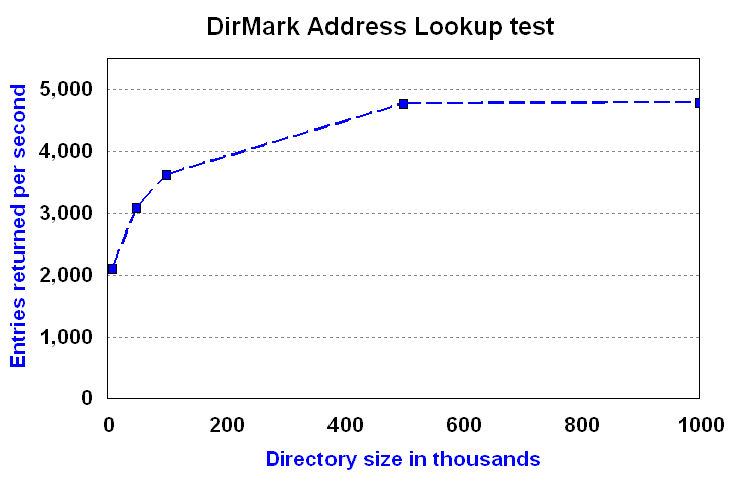
In this situation, the number of entries returned per second is a truer measure of throughput than operations per second, because each operation requires more work to be performed as the size of the database grows.
The IBM Directory uses DB2 as the data store and Structured Query Language (SQL) as the query retrieval mechanism. While the LDAP server caches LDAP queries, answers, and authentication information, DB2 caches tables, indexes, and statements.
Many DB2 configuration parameters affect either the memory (buffer pools) or disk resources. Since disk access is usually much slower than memory access, the key database performance tuning objective is to decrease the amount of disk activity.
This chapter covers the following DB2 tunings:
Attention: Only users listed as database administrators can execute the DB2 commands. Make sure the ID running the DB2 commands is a user in the dbsysadm group (UNIX(R) operating systems) or a member of the Administrator group (Windows operating systems.) This includes the DB2 instance owner and root.
If you have any trouble running the DB2 commands, check to ensure the DB2 environment variables have been established by running db2profile (if not, the db2 get and db2 update commands will not work). The script file db2profile is located in the sqllib subdirectory under the instance owner's home directory. If you need to tailor this file, follow the comments inside the file to set your instance name, user paths, and default database name (the default path is /home/ldapdb2/sqllib/db2profile.) It is assumed that the user is logged in as ibm-slapdDbUserId. If logged in as the root user on a UNIX operating system, it is possible to switch to the instance owner as follows:
su - instance owner
where instance owner is the defined owner of the LDAP database.
To log on as the database administrator on a Windows 2000 operating system, run the following command:
runas /user:instance owner db2cm
where instance owner is the defined owner of the LDAP database.
For additional stability and performance enhancements, upgrade to the latest version of DB2.
DB2 buffer pool tuning is one of the most significant DB2 performance tunings. A buffer pool is a data cache between LDAP and the physical DB2 database files for both tables and indexes. DB2 buffer pools are searched when entries and their attributes are not found in the entry cache. Buffer pool tuning typically needs to be done when the database is initially loaded and when the database size changes significantly.
There are several considerations to keep in mind when tuning the DB2 buffer pools, for example:
To get the current DB2 buffer pool sizes, run the following commands:
db2 connect to instance owner db2 "select bpname,npages,pagesize from SYSIBM.SYSbufferpools"
where instance owner is the defined owner of the database.
The following example output shows the default settings for the example above:
BPNAME NPAGES PAGESIZE ------------------ ----------- ----------- IBMDEFAULTBP 29500 4096 LDAPBP 1230 32768 2 record(s) selected.
In IBM Directory Server 5.1, the LDAP directory database (DB2) has two buffer pools, LDAPBP and IBMDEFAULTBP. The size of each buffer pool needs to be set separately, but the method for determining how big each should be is the same: Run your workload with the buffer pool sizes set to different values and measure the differences in operations per second.
This buffer pool contains cached entry data (ldap_entry) and all of the associated indexes. LDAPBP is similar to to the entry cache, except that LDAPBP uses different algorithms in determining what entries are cached. It is possible that an entry that is not cached in the entry cache is located in LDAPBP.
To determine the best size for your LDAPBP buffer pool, run your workload with LDAPBP buffer pool size set to different values and measure the differences in operations per second. For example, Figure 8 shows the varying operations per second based on different LDAPBP buffer pool sizes:
Figure 8. Varying the size of LDAPBP
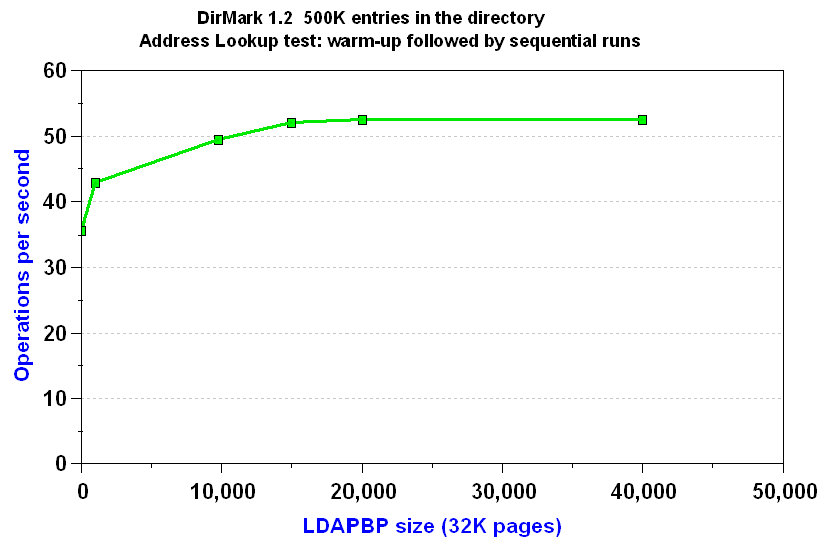
For the workload in the above example, the best performance results from a LDAPBP size of approximately 15,000 32K pages. However, the performance gain of 15,000 over a size of 9,800 is slight. In a memory-constrained environment, setting the LDAPBP size to 9,800 saves approximately 166MB of memory.
DB2 system information, including system tables and other LDAP information, is cached in the IBMDEFAULTBP. You may need to adjust the IBMDEFAULTBP cache settings for better performance in the LDAPBP.
To determine the best size for your IBMDEFAULTBP buffer pool, run your workload with the buffer pool sizes set to different values and measure the differences in operations per second. For example, Figure 9 shows the varying operations per second based on different IBMDEFAULTBP buffer pool sizes:
Figure 9. Varying the size of IBMDEFAULTBP

For the workload in the above example, setting the IBMDEFAULTBP large enough to hold the working set improves throughput more than three times over a small buffer pool size. There is little additional benefit to setting IBMDEFAULTBP larger than 20,000 4K pages.
Use the alter bufferpool command to set the IBMDEFAULTBP and LDAPBP buffer pool sizes. The following example shows the IBMDEFAULTBP and LDAPBP buffer pools being set:
db2 alter bufferpool ibmdefaultbp size 20000 db2 alter bufferpool ldapbp size 9800 db2 force applications all db2stop db2start
DB2 uses a sophisticated set of algorithms to optimize the access to data stored in a database. These algorithms depend upon many factors, including the organization of the data in the database, and the distribution of that data in each table. Distribution of data is represented by a set of statistics maintained by the database manager.
In addition, IBM Directory Server creates a number of indexes for tables in the database. These indexes are used to minimize the data accessed in order to locate a particular row in a table.
In a read-only environment, the distribution of the data changes very little. However, with updates and additions to the database, it is not uncommon for the distribution of the data to change significantly. Similarly, it is quite possible for data in tables to become ordered in an inefficient manner.
To remedy these situations, DB2 provides tools to help optimize the access to data by updating the statistics and to reorganize the data within the tables of the database.
Optimizing the database updates statistics related to the data tables, which improves performance and query speed. Optimize the database periodically or after heavy database updates, for example, after importing database entries. The IBM Directory Server Optimize button uses DB2 runstats to update statistical information used by the query optimizer for all the LDAP tables.
To optimize the database using the Configuration Tool:
After a message displays indicating the database was successfully optimized, you must restart the server for the changes to take effect.
To optimize the database using the command line, run the following command:
DB2 RUNSTATS ON TABLE table-name AND DETAILED INDEXES ALL SHRLEVEL REFERENCE
Run the following commands for more detailed lists of runstats that improve performance:
DB2 RUNSTATS ON TABLE table-name WITH DISTRIBUTION AND DETAILED INDEXES ALL SHRLEVEL REFERENCE
DB2 RUNSTATS ON TABLE ldapdb2.objectclass WITH DISTRIBUTION AND DETAILED INDEXES ALL SHRLEVEL REFERENCE
Tuning the organization of the data in DB2 using the reorgchk and reorg commands is important for optimal performance.
reorgchk updates statistical information to the DB2 optimizer to improve performance, and reports statistics on the organization of the database tables.
reorg, using the data generated by reorgchk, reorganizes table spaces to improve access performance and reorganizes indexes so that they are more efficiently clustered. The reorgchk and reorg commands can improve both search and update operation performance.
After a number of updates have been performed against DB2, table indexes can become sub-optimal and performance can degrade. Correct this situation by performing a DB2 reorgchk as follows:
db2 connect to ldapdb2 db2 reorgchk update statistics on table all
Where ldapdb2 is the name of your database.
To generate a reorgchk output file (recommended if you plan to run the reorg command) add the name of the file to the end of the command, for example:
db2 reorgchk update statistics on table all >reorgchk.out
A sample reorgchk report looks something like this:
db2 => reorgchk current statistics on table all Table statistics: F1: 100 * OVERFLOW / CARD < 5 F2: 100 * TSIZE / ((FPAGES-1) * (TABLEPAGESIZE-76)) > 70 F3: 100 * NPAGES / FPAGES > 80 CREATOR NAME CARD OV NP FP TSIZE F1 F2 F3 REORG -------------------------------------------------------------------------------- LDAPDB2 ACLPERM 2 0 1 1 138 0 - 100 --- LDAPDB2 ACLPROP 2 0 1 1 40 0 - 100 --- LDAPDB2 ALIASEDOBJECT - - - - - - - - --- LDAPDB2 AUDIT 1 0 1 1 18 0 - 100 --- LDAPDB2 AUDITADD 1 0 1 1 18 0 - 100 --- LDAPDB2 AUDITBIND 1 0 1 1 18 0 - 100 --- LDAPDB2 AUDITDELETE 1 0 1 1 18 0 - 100 --- LDAPDB2 AUDITEXTOPEVENT 1 0 1 1 18 0 - 100 --- LDAPDB2 AUDITFAILEDOPONLY 1 0 1 1 18 0 - 100 --- LDAPDB2 AUDITLOG 1 0 1 1 77 0 - 100 --- ... SYSIBM SYSINDEXCOLUSE 480 0 6 6 22560 0 100 100 --- SYSIBM SYSINDEXES 216 114 14 28 162216 52 100 50 *-* ... SYSIBM SYSPLAN 79 0 6 6 41554 0 100 100 --- SYSIBM SYSPLANAUTH 157 0 3 3 9106 0 100 100 --- SYSIBM SYSPLANDEP 35 0 1 2 5985 0 100 50 --* -------------------------------------------------------------------------------- Index statistics: F4: CLUSTERRATIO or normalized CLUSTERFACTOR > 80 F5: 100 * (KEYS * (ISIZE+8) + (CARD-KEYS) * 4) / (NLEAF * INDEXPAGESIZE) > 50 F6: (100-PCTFREE) * (INDEXPAGESIZE-96) / (ISIZE+12) ** (NLEVELS-2) * (INDEXPAGES IZE-96) / (KEYS * (ISIZE+8) + (CARD-KEYS) * 4) < 100 CREATOR NAME CARD LEAF LVLS ISIZE KEYS F4 F5 F6 REORG -------------------------------------------------------------------------------- Table: LDAPDB2.ACLPERM LDAPDB2 ACLPERM_INDEX 2 1 1 6 2 100 - - --- Table: LDAPDB2.ACLPROP LDAPDB2 ACLPROP_INDEX 2 1 1 6 2 100 - - --- Table: LDAPDB2.ALIASEDOBJECT LDAPDB2 ALIASEDOBJECT - - - - - - - - --- LDAPDB2 ALIASEDOBJECTI - - - - - - - - --- LDAPDB2 RALIASEDOBJECT - - - - - - - - --- Table: LDAPDB2.AUDIT LDAPDB2 AUDITI 1 1 1 4 1 100 - - --- Table: LDAPDB2.AUDITADD LDAPDB2 AUDITADDI 1 1 1 4 1 100 - - --- Table: LDAPDB2.AUDITBIND LDAPDB2 AUDITBINDI 1 1 1 4 1 100 - - --- Table: LDAPDB2.AUDITDELETE LDAPDB2 AUDITDELETEI 1 1 1 4 1 100 - - --- Table: LDAPDB2.AUDITEXTOPEVENT ... Table: LDAPDB2.SN LDAPDB2 RSN 25012 148 2 14 25012 99 90 0 --- LDAPDB2 SN 25012 200 3 12 25012 99 61 119 --* LDAPDB2 SNI 25012 84 2 4 25012 99 87 1 --- ... Table: LDAPDB2.TITLE LDAPDB2 TITLEI - - - - - - - - --- Table: LDAPDB2.UID LDAPDB2 RUID 25013 243 3 17 25013 0 62 79 *-- LDAPDB2 UID 25013 273 3 17 25013 100 55 79 --- LDAPDB2 UIDI 25013 84 2 4 25012 100 87 1 --- Table: LDAPDB2.UNIQUEMEMBER LDAPDB2 RUNIQUEMEMBER 10015 224 3 47 10015 1 60 44 *-- LDAPDB2 UNIQUEMEMBER 10015 284 3 47 10015 100 47 44 -*- LDAPDB2 UNIQUEMEMBERI 10015 14 2 4 7 100 69 8 --- ... Table: SYSIBM.SYSFUNCTIONS SYSIBM IBM127 141 1 1 13 141 65 - - *-- SYSIBM IBM25 141 2 2 34 141 100 72 60 --- SYSIBM IBM26 141 2 2 32 141 78 68 63 *-- SYSIBM IBM27 141 1 1 23 68 80 - - *-- SYSIBM IBM28 141 1 1 12 2 99 - - --- SYSIBM IBM29 141 1 1 4 141 100 - - --- SYSIBM IBM30 141 3 2 59 141 78 76 38 *-- SYSIBM IBM55 141 2 2 34 141 99 72 60 --- ... -------------------------------------------------------------------------------- CLUSTERRATIO or normalized CLUSTERFACTOR (F4) will indicate REORG is necessary for indexes that are not in the same sequence as the base table. When multiple indexes are defined on a table, one or more indexes may be flagged as needing REORG. Specify the most important index for REORG sequencing.
Using the statistics generated by reorgchk, run reorg to update database table organization. See Performing a reorg.
Keep in mind that reorgchk needs to be run periodically. For example, reorgchk might need to be run after a large number of updates have been performed. Note that LDAP tools such as ldapadd, ldif2db and bulkload can potentially do large numbers of updates that require a reorgchk. The performance of the database should be monitored and a reorgchk performed when performance starts to degrade. See Monitoring performance for more information.
reorgchk must be performed on all LDAP replicas, since each uses a separate database. The LDAP replication process does not include the propagation of database optimizations.
In general, reorganizing a table takes more time than running statistics. Therefore, performance might be improved significantly by running statistics first.
Because LDAP caches prepared DB2 statements, you must stop and restart ibmslapd in order for DB2 changes to take effect.
After you have generated organizational information about the database using reorgchk, the next step in reorganization is finding the tables and indexes that need reorganizing and attempting to reorganize them. This can take a long time. The time it takes to perform the reorganization process increases as the DB2 database size increases.
To reorganize database table information:
db2 reorgchk update statistics on table all >reorgchk.out
The reorgchk update statistics report has two sections; the first section is the table information and the second section is the indexes. An asterisk in the last column indicates a need for reorganization.
db2 reorg table table name
where table name is the name of the table to be reorganized, for example. LDAPDB2.LDAP_ENTRY.
Generally speaking, since most data in LDAP is accessed by index, reorganizing tables is usually not as beneficial as reorganizing indexes.
db2 reorg table table name index index name
where table name is the name of the table, for example, LDAPDB2.LDAP_ENTRY. And where index name is the name of the index, for example, SYSIBM.SQL000414155358130.
Some guidelines for performing a reorganization are:
For example:
| Table: LDAPDB2.SECUUID |
|---|
| LDAPDB2 RSECUUID <-- This is a reverse index |
| LDAPDB2 SECUUID <-- This is a forward index |
| LDAPDB2 SECUUIDI <-- This is an update index |
Indexing results in a considerable reduction in the amount of time it takes to locate requested data. For this reason, it can be very beneficial from a performance standpoint to index all attributes used in searches.
Use the following DB2 commands to verify that a particular index is defined. In the following example, the index being checked is for the attribute principalName:
db2 connect to database name db2 list tables for all | grep -i principalName db2 describe indexes for table database name.principalName
Where database name is the name of your database.
If the second command fails or the last command does not return three entries, the index is not properly defined. The last command should return the following results:
IndexSchema Index Name Unique Rule Number of Columns
------------- ------------------- ---------- -------------
LDAPDB2 PRINCIPALNAMEI D 1
LDAPDB2 PRINCIPALNAME D 2
LDAPDB2 RPRINCIPALNAME D 2
3 record (s) selected.
To have IBM Directory Server create an index for an attribute the next time IBM Directory Server is started, do one of the following:
ldapmodify -f /ldap/etc/addindex.ldif
The addindex.ldif file should look like this:
dn: cn=schema changetype: modify replace: attributetypes attributetypes: ( 1.3.18.0.2.4.318 NAME ( 'principalName' 'principal' ) DESC 'A naming attribute that may be used to identify eUser object entries.' EQUALITY 1.3.6.1.4.1.1466.109.114.2 ORDERING 2.5.13.3 SUBSTR 2.5.13.4 SYNTAX 1.3.6.1.4.1.1466.115.121.1.15 USAGE userApplications ) - replace: ibmattributetypes ibmattributetypes: ( 1.3.18.0.2.4.318 DBNAME( 'principalName' 'principalName' ) ACCESS-CLASS normal LENGTH 256 EQUALITY ORDERING SUBSTR APPROX )
Performance benefits can come from setting other DB2 configuration parameters, such as APPLHEAPZ and LOGFILSIZ. The current setting of parameters can be obtained by issuing the following command:
db2 get database configuration for database name
where database name is the name of your database.
This command returns the settings of other DB2 configuration parameters as well.
The following command also shows the DB2 configuration parameters for the entire database instance:
db2 get database manager configuration
To set the DB2 configuration parameters use the following syntax:
db2 update database configuration for database name using \ parm name parm value db2stop db2start
where database name is the name of your database and where parm name is the parameter to change and parm value is the value it is to be assigned.
Changes to DB2 configuration parameters do not take effect until the database is restarted with db2stop and db2start.
For a list of DB2 parameters that affect performance, visit the DB2 Web site: http://www.ibm.com/software/data/db2
When using the database backup and restore commands it is important to keep in mind that when you restore over an existing database, any tuning that has been done on that existing database is lost.
This chapter discusses the following performance tuning tasks for the AIX operating system:
The underlying AIX operating system files that hold the contents of a large directory can grow beyond the default size limits imposed by the AIX operating system. If the size limits are reached, the directory ceases to function correctly. The following steps make it possible for files to grow beyond default limits on an AIX operating system:
The MALLOCMULTIHEAP environment variable can improve LDAP performance on SMP systems. To set this variable, run the following command just before starting ibmslapd:
export MALLOCMULTIHEAP=1
The disadvantage to using MALLOCMULTIHEAP is increased memory usage.
It might take less memory, yet have less of a performance benefit, if the variable is set as follows:
export MALLOCMULTIHEAP=heaps: numprocs+1
where numprocs is the number of processors in the multiprocessor system.
More information on MALLOCMULTIHEAP can be found in the AIX documentation.
To view the environment settings and variables for your ibmslapd process, run the following command:
ps ewww PID
where PID is the ibmslapd process ID.
Example output for a PID of 27594:
$ ps ewww 27594
PID TTY STAT TIME COMMAND
27594 pts/2 A 0:02 ibmslapd -n -f /home/gwllmz/Test/Unit/Repl/
taliesin.ibmslapd.conf _=/usr/bin/ibmslapd LANG=en_US LOGIN=root IMQCONFIGCL
/etc/IMNSearch/dbcshelp PATH=/usr/bin:/etc:/usr/sbin:/usr/local/bin:/usr/
contrib/bin:/usr/prod/bin:/usr/ucb://bin:/usr/bin/X11:/sbin:/
usr/lib/netls/conf/nodelock:.:/usr/bin:/etc:/usr/sbin:/usr/ucb:/usr/bin/
X11:/sbin:/home/ldapdb2/sqllib/bin:/home/ldapdb2/sqllib/adm:/home/ldapdb2/
sqllib/misc ID=root LC__FASTMSG=true IMQCONFIGSRV=/
etc/IMNSearch CGI_DIRECTORY=/var/docsearch/cgi-bin CLASSPATH=/home/ldapdb2/
sqllib/java/db2java.zip:/home/ldapdb2/sqllib/java/db2jcc.jar:/home/ldapdb2/
sqllib/java/sqlj.zip:/home/ldapdb2/sqllib/function:
. LOGNAME=root MAIL=/usr/spool/mail/root LOCPATH=/usr/lib/nls/
loc HNAME=taliesin PS1=[$ID@$HNAME: $PWD ]?==> OS=AIX VWSPATH=/home/
ldapdb2/sqllib DOCUMENT_SERVER_MACHINE_NAME=localhost
USER=root AUTHSTATE=compat _EUC_SVC_DBG_LOGGING=1 DCE_USE_WCHAR_NAMES=
1 _EUC_SVC_DBG_FILENAME=/tmp/gss.out SHELL=/bin/ksh ODMDIR=/etc/objrepos JAVA_HOME=/
usr/jdk_base DOCUMENT_SERVER_PORT=49213
_EUC_SVC_DBG=*.8 HOME=/ DB2INSTANCE=ldapdb2 VWS_TEMPLATES=/home/
ldapdb2/sqllib/templates LD_LIBRARY_PATH=:/home/ldapdb2/sqllib/lib TERM=vt220 MAILMSG=
[YOU HAVE NEW MAIL] PWD=/home/gwllmz/Defects/77260/aus51ldap.20021106a DOCUMENT_DIRECTORY=/
usr/docsearch/html TZ=CST6CDT
TRY_PE_SITE=1 VWS_LOGGING=/home/ldapdb2/sqllib/logging A__z=! LOGNAME LIBPATH=/
usr/lib:/usr/ldap/java/bin:/usr/ldap/java/bin/classic:/home/ldapdb2/sqllib/
lib NLSPATH=/usr/lib/nls/msg/%L/%N:/usr/lib/nls/msg/%L/%N.cat KRB5_KTNAME=/home/
gwllmz/Test/Unit/Repl/taliesin.keytab
ODBCCONN=15
This chapter contains some suggestions for improving disk drive performance.
With millions of entries in LDAP server, it can become impossible to cache all of them in memory. Even if a smaller directory size is cacheable, update operations must go to disk. The speed of disk operations is important. Here are some considerations for helping to improve disk drive performance:
The sections in this chapter briefly describe the following additional performance-related IBM Directory features.
The bulkload utility loads directory data to the LDAP database using an LDIF file. bulkload usually is significantly faster than ldif2db and ldapadd when loading approximately 100,000 to a million entries. Read the bulkload documentation in the IBM Directory Server Version 5.1 Administration Guide for information about using bulkload.
IBM Directory Server supports replication. Through replication, multiple, synchronized copies of directory data are maintained on multiple directory servers. Using replication can improve performance related to search throughput because the workload can be divided across several servers. This allows for an enterprise's LDAP search activity to be distributed among several servers.
In the configuration of replication, you can specify that updates be replicated either immediately, or at scheduled times. If your application environment does not depend on the updates occurring immediately, it might be beneficial to schedule replication for off-peak hours, or on some more frequent, periodic basis. This will cause the updates to be batched together, reducing the cost of cache invalidation that results from updates on the replica servers.
Replication also adds to the workload on the master server where the updates are first applied. In addition to updating its copy of the directory data, the master server must send the changes to all replica servers. Careful scheduling of replication to avoid peak activity times will help minimize the impact to throughput on the master server.
The following ldapsearch command can be used to monitor performance.
ldapsearch -h ldap_host -s base -b cn=monitor objectclass=*
where ldap_host is the name of the LDAP host.
The monitor search returns some of the following attributes of the server:
year month day hour:minutes:seconds GMT
day month date hour:minutes:seconds timezone year
year month day hour:minutes:seconds GMT
day month date hour:minutes:seconds timezone year
The following example shows how to calculate the throughput of the server by monitoring the server statistic called opscompleted, which is the number of operations completed since the LDAP server started.
Suppose the values for the opscompleted attribute obtained by issuing two ldapsearch commands to monitor the performance statistics, one at time t1 and the other at a later time t2, were opscompleted (t1) and opscompleted(t2.) Then, the average throughput at the server during the interval between t1 and t2 can be calculated as:
(opscompleted(t2) - opscompleted(t1) - 3)/(t2 -t1)
(3 is subtracted to account for the number of operations performed by the ldapsearch command itself.)
IBM Directory 5.1 has a function called change log that results in a significantly slower LDAP update performance. The change log function should be configured only if needed.
The change log function causes all updates to LDAP to be recorded in a separate change log DB2 database (that is, a different database from the one used to hold the LDAP server Directory Information Tree). The change log database can be used by other applications to query and track LDAP updates. The change log function is disabled by default.
One way to check for existence of the change log function is to look for the suffix CN=CHANGELOG. If it exists, the change log function is enabled.
If you are experiencing problems with the performance of your directory server, refer to this section for possible fixes and workarounds.
This section contains some methods for identifying areas that might be affecting the performance of your directory server.
The audit log shows what searches are being performed and the parameters used in each search. The audit log also shows when a client binds and unbinds from the directory. Observing these measurements allows you to identify LDAP operations that take a long time to complete.
Taking an ibmslapd trace provides a list of the SQL commands issued to the DB2 database. These commands can help you identify operations that are taking a long time to complete. This information can in turn lead you to missing indexes, or unusual directory topology. To turn the ibmslapd trace on, run the following commands:
After you have turned the trace on, run the commands that you think might be giving you trouble.
Running a trace on several operations can slow performance, so remember to turn the trace off when you are through using it:
ldaptrc off
Memory added to a computer after the installation of a Solaris operating system does not automatically improve performance. To take advantage of added memory, you must:
set shmsys:shminfo_shmmax = physical memory
Where physical memory is the size on of the physical memory on the machine in bytes.
You must reboot for the new settings to take effect.
ulimit -d unlimited ulimit -v unlimited ulimit -f unlimited
If you are experiencing rollback activities in DB2, check the isolation level. Rollbacks occur when one application process has a row locked while another application process tries to access that same row. Because the default isolation level, repeatable read, can result in more rows being locked than are actually required for the current read request, a more relaxed isolation level is normally recommended for LDAP applications.
For example, the read stability isolation level allows other applications to insert or update data in rows which have been read. If a second read is issued for that range of rows, the new data is reflected in the result set. Keep in mind, however, that the second read can return data that is different from the first read. If an application depends upon the same data being returned on multiple reads, the isolation level should be set to repeatable read.
To set the DB2 isolation level, type the following at a command prompt:
db2set <isolation level>=YES
where isolation level is the isolation level you want to apply, such as DB2_RR_TO_RS.
DirectoryMark 1.2 is an industry-standard benchmark provided by Mindcraft Inc. as a performance test for LDAP implementations.
http://www.mindcraft.com/directorymark/
DirMark 1.2 consists of a loading phase and two scenarios, Messaging and Address Lookup. Both Messaging and Address Lookup consist entirely of searches; there are no updates.
Each scenario consists of two phases, a warmup phase and a run phase. During the warmup phase, the searches primarily request entries that are not in the LDAP caches; most of these requests require interaction with the DB2 backing store. For all the measurements reported in this document, warmup consisted of running all queries at least once; consequently, during the run phase all entries requested are potentially already in LDAP caches in memory if the caches are large enough to hold all of them. Thus the warmup phase and the run phase comprise two distinctly different workloads.
During the run phase of Address Lookup, a number of client threads issue search requests to the IBM Directory Server from predetermined scripts. The scripts include a number of different kinds of searches, including wildcard and other searches that return multiple entries per request. The client threads run through their scripts continuously for three minutes. Throughput is measured on the server for each three-minute interval, and then each client starts over at the beginning of its script. Each three-minute interval is referred to as a run. The server is not restarted between runs.
The examples in this guide use the following platform configurations:
This information was developed for products and services offered in the U.S.A. IBM might not offer the products, services, or features discussed in this document in other countries. Consult your local IBM representative for information on the products and services currently available in your area. Any reference to an IBM product, program, or service is not intended to state or imply that only that IBM product, program, or service may be used. Any functionally equivalent product, program, or service that does not infringe any IBM intellectual property right may be used instead. However, it is the user's responsibility to evaluate and verify the operation of any non-IBM product, program, or service.
IBM may have patents or pending patent applications covering subject matter in this document. The furnishing of this document does not give you any license to these patents. You can send license inquiries, in writing, to:
IBM Director of LicensingFor license inquiries regarding double-byte (DBCS) information, contact the IBM Intellectual Property Department in your country or send inquiries, in writing, to:
IBM World Trade Asia Corporation LicensingThe following paragraph does not apply to the United Kingdom or any other country where such provisions are inconsistent with local law: INTERNATIONAL BUSINESS MACHINES CORPORATION PROVIDES THIS PUBLICATION "AS IS" WITHOUT WARRANTY OF ANY KIND, EITHER EXPRESS OR IMPLIED, INCLUDING, BUT NOT LIMITED TO, THE IMPLIED WARRANTIES OF NON-INFRINGEMENT, MERCHANTABILITY OR FITNESS FOR A PARTICULAR PURPOSE. Some states do not allow disclaimer of express or implied warranties in certain transactions, therefore, this statement may not apply to you.
This information could include technical inaccuracies or typographical errors. Changes are periodically made to the information herein; these changes will be incorporated in new editions of the information. IBM may make improvements and/or changes in the product(s) and/or the program(s) described in this information at any time without notice.
Any references in this information to non-IBM Web sites are provided for convenience only and do not in any manner serve as an endorsement of those Web sites. The materials at those Web sites are not part of the materials for this IBM product and use of those Web sites is at your own risk.
IBM may use or distribute any of the information you supply in any way it believes appropriate without incurring any obligation to you.
Licensees of this program who wish to have information about it for the purpose of enabling: (i) the exchange of information between independently created programs and other programs (including this one) and (ii) the mutual use of the information which has been exchanged, should contact:
IBM CorporationSuch information may be available, subject to appropriate terms and conditions, including in some cases, payment of a fee.
The licensed program described in this document and all licensed material available for it are provided by IBM under terms of the IBM Customer Agreement, IBM International Program License Agreement, or any equivalent agreement between us.
Any performance data contained herein was determined in a controlled environment. Therefore, the results obtained in other operating environments may vary significantly. Some measurements may have been made on development-level systems and there is no guarantee that these measurements will be the same on generally available systems. Furthermore, some measurement may have been estimated through extrapolation. Actual results may vary. Users of this document should verify the applicable data for their specific environment.
Information concerning non-IBM products was obtained from the suppliers of those products, their published announcements or other publicly available sources. IBM has not tested those products and cannot confirm the accuracy of performance, compatibility or any other claims related to non-IBM products. Questions on the capabilities of non-IBM products should be addressed to the suppliers of those products.
All statements regarding IBM's future direction or intent are subject to change or withdrawal without notice, and represent goals and objectives only.
All IBM prices shown are IBM's suggested retail prices, are current and are subject to change without notice. Dealer prices may vary.
The following terms are trademarks of International Business Machines
Corporation in the United States, or other countries, or both:
| AIX | DB2 | IBM |
Microsoft(R), MS-DOS, Windows, and Windows NT(R) are registered trademarks of Microsoft Corporation
Other company, product, and service names may be trademarks or service marks of others.